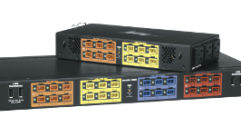

CES 2011: You Had to Be There
Did you miss the 2011 International Consumer Electronics Show, where trend-setting products affect pro AV? No problem. Here are 10 technologies worth keeping on the radar.
Pete Putman
Credit: Chris Whitney
By my own reckoning, i’ve made more than 60 trips to Las Vegas in the past 15 years for everything from the InfoComm and National Association of Broadcasters trade shows to ShoWest,Lighting Dimensions International, the late Comdex computer exposition, and numerous dealer and manufacturer events. But none of them compares with the craziness that is the International Consumer Electronics Show (CES), a four-day celebration of gadgetry that takes center stage at the start of every year.
In the past, the pro AV market didn’t pay much attention to CES. It was understood that pro AV got the new, cutting-edge technologies first and innovations eventually trickled down to consumers. Think of the first CCD cameras, digital video recording and editing, VHS and laser-disc formats, and CRT projectors. But that’s all changed. Now the cutting-edge products are likely to debut at Amazon.com, Best Buy, RadioShack, and Walmart, with pro versions almost an afterthought. DVDs, LED backlights, HDMI, and 1080p displays took their first steps in the CE world.
As an AV professional, you’re no doubt asked by clients to add some level of CE product functionality to commercial installations. Think Wi-Fi, Blu-ray, 3D, NeTVs, and smart phones. The often-reviled HDMI standard has permeated every level of pro AV equipment, for better or worse. Now new home networking standards such as HDBaseT and DiiVA are making inroads (see “The Long Haul,” page 8). So what’s an AV pro to do except keep a close eye on CES?
Now that I’ve had a few days to recuperate from my latest trip to Vegas, here are 10 intriguing products from 2011 International:
Transparent organic light-emitting diode (OLED) displays: Samsung showed a partially transparent OLED laptop screen last year, but it topped itself this time around with its demonstration of a 19-inch transparent OLED display mounted in front of a shadow box. The 960×540-pixel display showed clips of a Victoria’s Secret fashion show playing over a diorama of a dollhouse bedroom, and exhibiting excellent contrast, saturated colors, and sharp detail.
Autotracking, autostereoscopic 3D: Toshiba demonstrated a 15-inch laptop screen with optical barrier technology for glasses-free 3D viewing. No big deal there, except that a camera built into the laptop triangulates on your facial features, then dynamically adjusts the liquid-crystal array to maintain the stereo effect as you move your head from side to side. Other viewers see only a 2D version of the image.
Wireless, uncompressed multichannel audio: Summit Semiconductor showed a demonstration of 5-GHz multichannel audio, sending 7.1-channel surround sound to randomly arranged speakers. How’d they optimize the sweet spot? With a proprietary ultrasonic Doppler function that readjusts audio levels for any seated or standing position in half a second with the tap of a button.
Mitsubishi Diamond Vision OLED wall: This product had its North American debut at CES. It’s a 155-inch videowall made of tiled RGB OLED emitters that come in 15-inch square blocks, each with a resolution of 128×128 pixels (about a 3mm pitch). The emitters are rated at 1,200 nits and have eye-popping color, plus the usual wide viewing angles associated with OLEDs. Good for indoor and outdoor digital signage.
Super-thin LCD bezels: We’re getting closer to the day when TVs and monitors have no bezel at all, or perhaps a mostly transparent bezel. At the Digital Experience tabletop show, Samsung featured a 55-inch LCD TV with a half-inch-thick silver bezel. Over at its booth, the UT550 LCD videowall featured quarter-inch black bezels around 55-inch LCD monitors.
Silicon Image ViaPort: ViaPort solves some of the common HDMI headaches by routing all media sources through a ViaPort-enabled TV and employing a single HDMI-out connection to feed embedded audio to an external AV receiver in any format. It uses EDID from the receiver to feed the highest-level multichannel format supported, eliminating the usual complex and frustrating AVR configuration process. Another variation of ViaPort was used to daisy-chain eight LCD monitors from a single Blu-ray player in a digital signage application.
Wireless USB 3.0: Samsung also showed a “central station” concept demo that uses wireless USB 3.0 to autoconnect a laptop to a docking station simply by proximity detection. Move your laptop within 3 feet of the dock and the outboard monitor and USB-connected peripherals come alive. Move away, and they automatically power down. No more cables.
Wireless graphics cards: The WHDI Consortium and Amimon demonstrated an Nvidia workstation graphics card that connects using the WHDI wireless standard to any compatible monitor. Four separate transmitters are used to move the data, which at 1920×1200 resolution and 12-bit color depth is substantial.
A single-layer multitouch interface: Integrated Device Technology, the folks who bought Silicon Optix’s HQV Realta processor technology, showed what they said was the first true single-layer, capacitive multi-touchscreen technology for LCD and OLED screen sizes up to 5 inches. The advantages of a single-layer approach are brighter images, fewer electrodes, and lower manufacturing costs.
LG ST600 Smart TV Upgrader: Despite all the interest in Internet video, lots of people still have older LCD and plasma TVs that lack Ethernet ports. LG’s $150 ST600 can access popular streaming apps such as Netflix, Hulu Plus, CinemaNow, and YouTube while providing a browser for app selection. It connects to any HDMI port.
It was hard to winnow the list down to 10 items. If you want to know more, I’ll feature other goodies from CES, NAB, and the spring line shows during my annual Super Tuesday Display Technology session at InfoComm 2011 in Orlando, Fla.
Pete Putman is Pro AV’s senior contributing editor and former InfoComm Educator of the year. His new Pro AV e-newsletter, Wake-Up Call, covers all things digital video.










